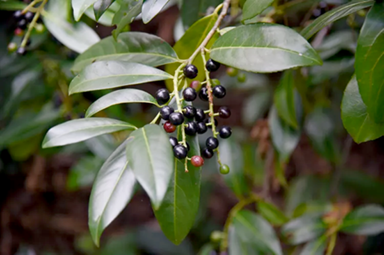Don’t rest on your laurels

By Susan Mates, Treekeepers of Washington County

Cherry laurels, or English laurels (Prunus laurocerasus) have glossy evergreen leaves, grow rapidly under most conditions, make good hedges, and sport upright clusters of white flowers in spring. What’s not to like about that?
Toxins, for one thing. In August and September, Cherry laurels form shiny black fruits that are poisonous to humans, dogs, and other animals. The concentration of their cyanogenic glycosides is particularly high in the leaves and seeds, but all parts of the Cherry laurel plant are poisonous. The fruits have a sweet aroma and are bitter in taste. As few as ten chewed fruits can cause death in children. Here are the typical symptoms of laurel poisoning.
There are other reasons to be wary of Cherry laurel. Those qualities that make gardeners choose them (evergreen, grow everywhere, difficult to kill) also make them invasive in urban parks and forests where they outcompete the native plants.
Birds and other animals distribute the seeds to remote areas, but Cherry laurels can also grow roots from stems that touch the ground or resprout from cut stems. Because these laurels thrive in sun or shade, wet or dry soils, and in disturbed ground, as well as grow very rapidly, native forest species such as tree seedlings and shrubs don’t stand a chance. Native canopy trees end up being replaced by laurels over time.
Are you ready to remove the Cherry laurels in your yard? Small plants can be dug up when soil is moist. Larger plants need to be cut as close to the ground as possible. Remove the stems, which can be chipped for mulch or placed in your yard waste containers. If possible, dig up the stumps and turn them upside down; their roots tend to be deep. Watch out for re-growth and regularly break off any new stems until the plant eventually stops sending up new shoots.
If you are having trouble imagining life without your Cherry laurels, consider these evergreen options you will learn to love.
Pacific Waxmyrtle (Myrica californica) grows in sun or partial shade and can withstand both damp locations and summer drought. It has root nodules containing nitrogen-fixing microorganisms, which allow it to grow in relatively nitrogen-poor soils. It can be used as a screen or can be pruned to keep it in shape. Considered one of the most attractive native western shrubs for the garden.
Oregon Grape (Mahonia aquifolium). Our state flower, this shrub is widely adapted to an array of soil conditions. It can be grown in either full sun or shade, although it prefers partial shade. The leaves will turn redder in the winter with more sun exposure.
California laurel (Umbellularia Californica). This is a more well-behaved cousin of the Cherry laurel. It has aromatic leaves that can be used as a seasoning. It is a shrub that can grow into a tree or pruned to stay from 6 to 8 feet tall. It prefers more than 30 inches of rainfall a year and grows naturally in Washington County.
Protecting mature trees is the mission of Treekeepers of Washington County. Contact us by email or visit our website to find out more.





